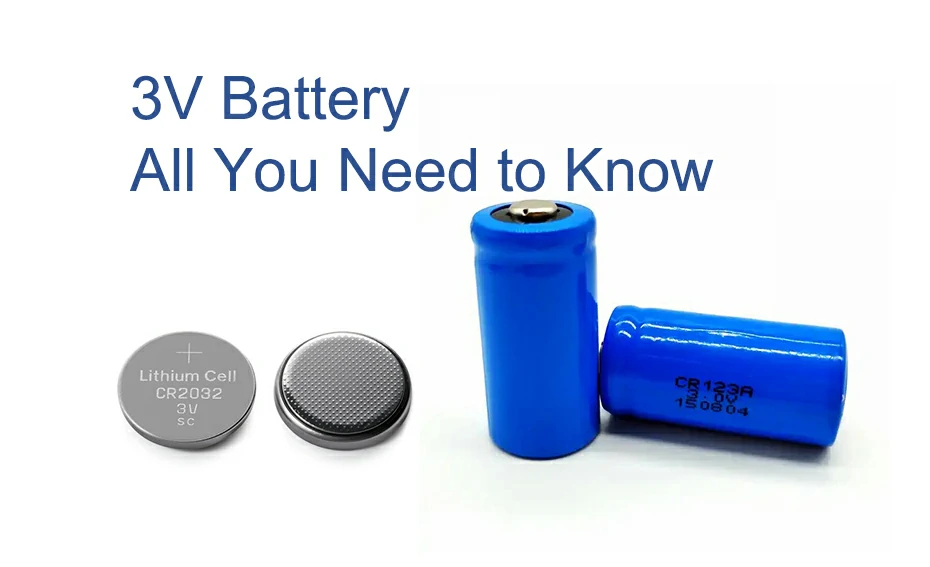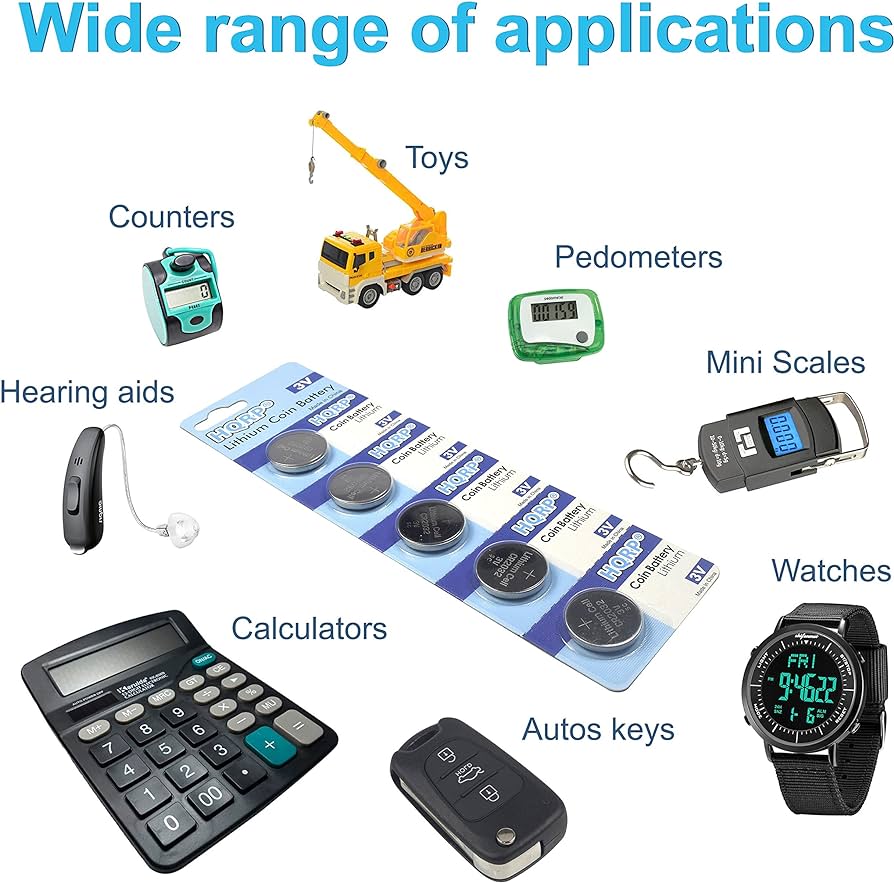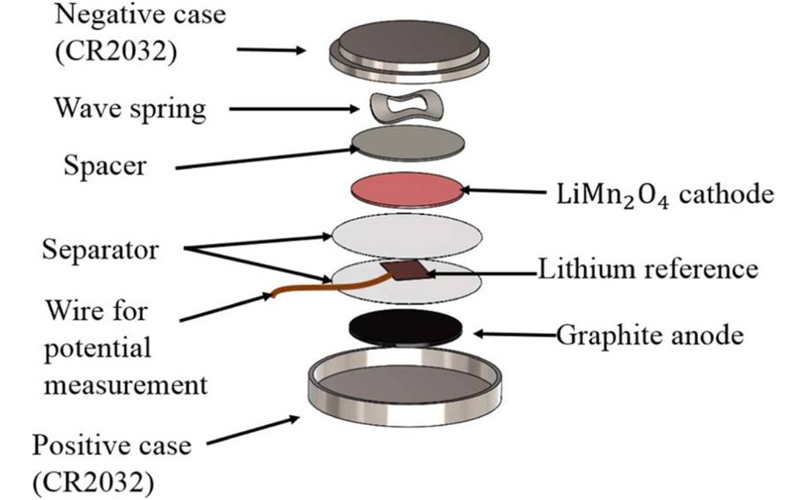
3V battery refers to a type of battery that has a nominal voltage output of 3 volts. The term "3V" stands for 3 volts, indicating the potential difference or electrical pressure that the battery can provide. These batteries are commonly used in a variety of electronic devices, ranging from small gadgets to larger appliances.
One example of a 3V battery is the widely used CR2032 battery. It is a coin cell battery with a diameter of 20 millimeters and a thickness of 3.2 millimeters. The "CR" in its name refers to the lithium manganese dioxide chemistry used in the battery. The CR2032 battery is commonly found in devices like wristwatches, calculators, key fobs, and small electronic toys.
The 3V voltage output is significant because many electronic components and circuits require a specific voltage level to function properly. By providing a stable 3 volts, these batteries ensure that the device receives the appropriate power supply to operate efficiently. It is important to note that the actual voltage of a 3V battery may vary slightly depending on factors such as the battery's charge level and load conditions.

When discussing different types of 3V batteries, we often compare them from the dimensions of shape and the materials utilized in the battery.
Coin cell batteries: Coin cell batteries are a common type of 3V battery and typically have a round, flat shape. One example is the CR2032 battery, which has a diameter of 20 millimeters and a thickness of 3.2 millimeters. It is commonly used in small electronic devices like watches, calculators, and key fobs.
Cylindrical batteries: Cylindrical 3V batteries come in various sizes and are often used in devices that require higher power output. For instance, the CR123A battery is a popular cylindrical 3V battery used in cameras, flashlights, and some medical devices. It has a diameter of about 17 millimeters and a length of about 34 millimeters.
Prismatic batteries: Prismatic 3V batteries have a thin, rectangular shape and are commonly used in slim electronic devices where space is a constraint. These batteries are often found in portable electronic devices like smartphones, tablets, and digital cameras. They are designed to be thin and lightweight while providing a stable 3V output.
Lithium manganese dioxide (Li-MnO₂) batteries
Energy density: High energy density, providing long-lasting power.
Shelf life: Excellent shelf life, often up to 10 years.
Temperature range: Wide operating temperature range, typically from -40°C to +85°C.
Safety: Generally safe with built-in protection circuits to prevent over-discharge and over-current.
Applications:
Consumer electronics: Widely used in devices like watches, calculators, and cameras due to their long life and consistent performance.
Medical devices: Suitable for medical equipment such as glucose monitors and hearing aids because of their reliability and long shelf life.
Automotive key fobs: Commonly used in car remote keyless entry systems due to their compact size and long-lasting power.
Lithium thionyl chloride (Li-SOCl₂) batteries
Energy density: Extremely high energy density.
Shelf life: Very long shelf life, often exceeding 10 years.
Temperature range: Can operate in extreme temperatures, from -55°C to +150°C.
Safety: Requires careful handling due to potentially hazardous chemicals and reactivity.
Applications:
Industrial applications: Ideal for applications that require long-term energy supply like utility meters, remote sensing devices, and asset tracking.
Military equipment: Used in military-grade electronics and equipment due to their reliability in extreme conditions.
Medical devices: Often found in critical medical devices that require long-term, uninterrupted power.
Lithium polymer (Li-Po) batteries
Energy density: High energy density, but less than Li-SOCl₂.
Shelf life: Moderate shelf life, usually around 2-3 years.
Temperature range: Moderate operating temperature range, usually from -20°C to +60°C.
Safety: Requires protection circuits to prevent overcharging, over-discharging, and short circuits.
Applications:
Portable electronics: Widely used in smartphones, tablets, and other portable devices due to their lightweight and flexible form factor.
RC models: Common in radio-controlled vehicles and drones because of their high discharge rates.
Wearable technology: Ideal for wearable devices such as smartwatches and fitness trackers due to their thin and flexible nature.
Alkaline batteries
Energy density: Lower energy density compared to lithium batteries.
Shelf life: Good shelf life, typically around 5 years.
Temperature range: Moderate operating temperature range, usually from -20°C to +54°C.
Safety: Generally safe and widely available.
Applications:
Household devices: Commonly used in remote controls, flashlights, and clocks.
Toys: Frequently found in childrens toys due to their availability and cost-effectiveness.
Basic electronics: Suitable for low-drain devices such as wall clocks and certain types of handheld gadgets.

Sure, let's delve into the working principle of a 3 volt lithium battery, such as a common lithium coin cell like the CR2032.
Electrode materials
The battery consists of two electrodes: a cathode (positive electrode) and an anode (negative electrode). In a lithium battery, the anode is usually made of lithium metal or a lithium alloy, while the cathode is composed of a lithium compound, such as lithium cobalt oxide (LiCoO₂), lithium manganese oxide (LiMnO₂), or lithium iron phosphate (LiFePO₄).
Electrolyte
Between the anode and cathode is an electrolyte, which can be a liquid or a solid-state material. The electrolyte allows for the movement of lithium ions but not electrons, facilitating the flow of current through an external circuit.
Discharge process
During discharge, which is the process of using the battery to power a device, lithium ions (Li⁺) move from the anode to the cathode through the electrolyte.
At the anode, lithium atoms release electrons which travel through the external circuit to the cathode, providing power to the connected device.
The lithium ions that have moved through the electrolyte recombine with the electrons at the cathode, creating a stable compound.
Charge process
The charging process is the reverse of discharging. The battery is connected to a charger, which pushes electrons back to the anode.
As electrons are pushed into the anode, lithium ions are released from the cathode and move back to the anode, where they recombine with the electrons to form lithium metal or alloy.
Safety features
Modern lithium batteries often include safety features such as a protective circuit to prevent overcharge, over-discharge, and short-circuiting, which can lead to overheating or other hazards.
Energy density and voltage
Lithium batteries are known for their high energy density, meaning they can store a lot of energy in a small volume, which is why they are widely used in compact devices.
The nominal voltage of a lithium battery is typically around 3.6 to 3.7 volts when fully charged, which can be stepped down to 3 volts for specific applications or through the use of multiple batteries in series or parallel configurations.
Environmental stability
Lithium batteries have a wide operating temperature range and can maintain their performance over a long period, contributing to their excellent shelf life.
3V batteries, particularly lithium manganese dioxide (Li-MnO₂) types, offer high energy density, allowing them to provide significant power relative to their small size. This makes them ideal for compact electronic devices such as watches, calculators, medical instruments, and various small gadgets that require reliable, long-lasting power. They also have an impressive shelf life, often lasting up to 10 years due to their low self-discharge rate, ensuring that they remain ready for use even after prolonged storage. Additionally, their wide operating temperature range, typically from -40°C to +85°C, makes them versatile for use in diverse environmental conditions, from extreme cold to intense heat.
Despite their many advantages, 3V batteries do have some drawbacks. One significant disadvantage is their relatively high cost compared to other types of batteries, which can be a consideration for high-volume usage or budget-sensitive applications. Additionally, while they provide excellent performance in low-drain devices, their capacity can be quickly depleted in high-drain applications, making them less suitable for devices that require a constant, heavy power draw. Furthermore, disposal and environmental concerns are associated with lithium batteries, as they contain chemicals that can be harmful if not properly recycled. This necessitates careful handling and disposal processes to minimize environmental impact.
To extend the life of 3V batteries, such as lithium manganese dioxide (Li-MnO₂) button cells, it is essential to follow several best practices and maintenance strategies. One of the most effective ways to prolong battery life is to store the batteries in a cool, dry place. High temperatures can accelerate the chemical reactions within the battery, leading to a faster depletion of its energy. Thus, keeping the batteries away from heat sources and direct sunlight is crucial. Moreover, it is advisable to store them in their original packaging or in a plastic container to prevent accidental short-circuiting.
Another important aspect is to avoid deep discharging the battery. Deep discharge occurs when a battery is used until it is completely drained, which can significantly reduce its overall lifespan. Instead, it is better to replace or recharge the battery before it reaches critically low levels. Additionally, if the device allows, switching it off when not in use can help conserve battery power. This is particularly relevant for devices that have standby modes, which can still consume a small amount of power.
Regularly cleaning the battery contacts can also make a significant difference. Dirt, dust, and corrosion on the contacts can impede the flow of electricity, causing the battery to work harder and drain faster. Using a soft cloth or a small brush to clean the contacts periodically can ensure a good connection and efficient power transfer.
Temperature management during use is another critical factor. While storing batteries in cool environments is beneficial, using them in extreme temperatures, both hot and cold, can adversely affect their performance and longevity. In cold temperatures, the battery's chemical reactions slow down, reducing its capacity temporarily. Conversely, in hot temperatures, the battery can overheat, which might lead to leakage or swelling. Therefore, it is best to use the batteries within the recommended temperature range specified by the manufacturer.
For rechargeable 3V batteries, such as lithium-ion versions, it is important to follow proper charging protocols. Using the correct charger and avoiding overcharging can prevent damage to the battery cells. Most modern chargers have built-in mechanisms to stop charging once the battery is full, but it is still good practice to monitor the charging process. Additionally, partial discharges followed by recharges are preferable to full discharge cycles, as they can help extend the battery's overall life.
By adhering to these guidelines—proper storage, avoiding deep discharges, regular cleaning of contacts, managing usage temperatures, and following proper charging practices—you can significantly extend the life of 3V batteries, ensuring they deliver consistent and reliable performance over a longer period.




The lab focuses on solid-state battery research to overcome traditional lithium batteries' safety and energy density issues, supporting environmental sustainability. It develops innovative solid-state electrolytes, refines electrode materials, and investigates ion transfer and interface stability to revolutionize battery technology.

The electric vehicle battery industry is rapidly developing, focusing on technological innovation, market competition, and sustainability. Research hotspots include solid-state batteries, new types of electrolytes, BMS optimization, and recycling technologies. The environmental adaptability, safety, and economic viability of batteries are key research areas, and the industry is expected to undergo more innovation and transformation.

Specializing in battery preparation technology research, the focus is on overcoming existing energy storage challenges by innovating in electrode materials, battery chemistry, and manufacturing processes to improve performance, safety, and reduce costs. Sustainability and recycling technologies for batteries are also emphasized to mitigate environmental impacts and foster the growth of green energy.